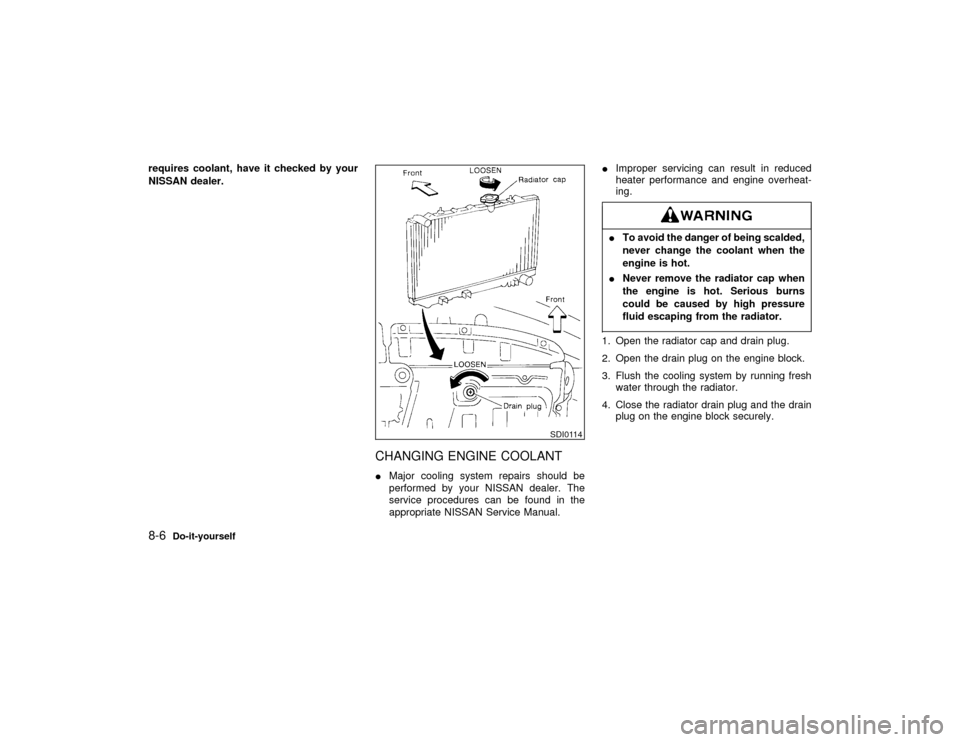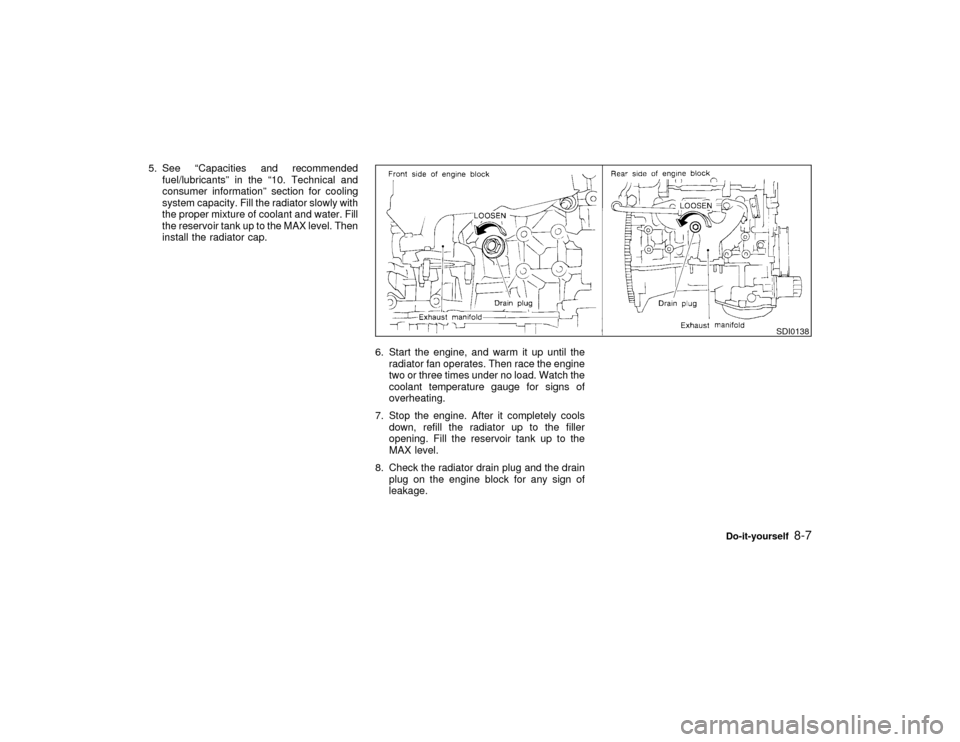1998 NISSAN MAXIMA engine overheat
[x] Cancel search: engine overheatPage 161 of 231

requires coolant, have it checked by your
NISSAN dealer.
CHANGING ENGINE COOLANTIMajor cooling system repairs should be
performed by your NISSAN dealer. The
service procedures can be found in the
appropriate NISSAN Service Manual.IImproper servicing can result in reduced
heater performance and engine overheat-
ing.
ITo avoid the danger of being scalded,
never change the coolant when the
engine is hot.
INever remove the radiator cap when
the engine is hot. Serious burns
could be caused by high pressure
fluid escaping from the radiator.1. Open the radiator cap and drain plug.
2. Open the drain plug on the engine block.
3. Flush the cooling system by running fresh
water through the radiator.
4. Close the radiator drain plug and the drain
plug on the engine block securely.
SDI0114
8-6
Do-it-yourself
Z
01.1.31/A32-D
X
Page 162 of 231

5. See ªCapacities and recommended
fuel/lubricantsº in the ª10. Technical and
consumer informationº section for cooling
system capacity. Fill the radiator slowly with
the proper mixture of coolant and water. Fill
the reservoir tank up to the MAX level. Then
install the radiator cap.
6. Start the engine, and warm it up until the
radiator fan operates. Then race the engine
two or three times under no load. Watch the
coolant temperature gauge for signs of
overheating.
7. Stop the engine. After it completely cools
down, refill the radiator up to the filler
opening. Fill the reservoir tank up to the
MAX level.
8. Check the radiator drain plug and the drain
plug on the engine block for any sign of
leakage.
SDI0138
Do-it-yourself
8-7
Z
01.1.31/A32-D
X
Page 206 of 231

NISSAN supports efforts towards cleaner air
and suggests that you use reformulated gaso-
line when available.Gasoline containing oxygenatesSome fuel suppliers sell gasoline containing
oxygenates such as ethanol, MTBE and
methanol with or without advertising their pres-
ence. NISSAN does not recommend the use of
fuels of which the oxygenate content and the
fuel compatibility for your NISSAN cannot be
readily determined. If in doubt, ask your ser-
vice station manager.
If you use oxygenate-blend gasoline, please
take the following precautions as the usage of
such fuels may cause vehicle performance
problems and/or fuel system damage.
IThe fuel should be unleaded and have
an octane rating no lower than that rec-
ommended for unleaded gasoline.
IIf an oxygenate-blend, excepting a
methanol blend, is used, it should con-
tain no more than 10% oxygenate.
(MTBE may, however, be added up to
15%.)
IIf a methanol blend is used, it should
contain no more than 5% methanol (me-
thyl alcohol, wood alcohol). It shouldalso contain a suitable amount of appro-
priate cosolvents and corrosion inhibi-
tors. If not properly formulated with ap-
propriate cosolvents and corrosion
inhibitors, such methanol blends may
cause fuel system damage and/or ve-
hicle performance problems. At this
time, sufficient data is not available to
ensure that all methanol blends are suit-
able for use in NISSAN vehicles.
If any undesirable driveability problems such
as engine stalling and hard hot starting are
experienced after using oxygenate-blend fu-
els, immediately change to a non-oxygenate
fuel or a fuel with a low blend of MTBE.
Take care not to spill gasoline during refu-
eling. Gasoline containing oxygenates can
cause paint damage.
Aftermarket fuel additivesNISSAN does not recommend the use of any
fuel additives (i.e. fuel injector cleaner, octane
booster, intake valve deposit removers, etc.)
which are sold commercially. Many of these
additives intended for gum, varnish or deposit
removal may contain active solvent or similar
ingredients that can be harmful to the fuel
system and engine.
Octane rating tipsIn most parts of North America, you should use
unleaded gasoline with an octane rating of at
least 87 or 91 AKI (Anti-Knock Index) number.
However, you may use unleaded gasoline with
an octane rating as low as 85 AKI number in
these high altitude areas [over 4,000 ft (1,219
m)] such as: Colorado, Montana, New Mexico,
Utah, Wyoming, northeastern Nevada, south-
ern Idaho, western South Dakota, western
Nebraska, and that part of Texas which is
directly south of New Mexico.
Using unleaded gasoline with an octane
rating lower than stated above can cause
persistent, heavy spark knock. (Spark
knock is a metallic rapping noise.) If se-
vere, this can lead to engine damage. If you
detect a persistent heavy spark knock even
when using gasoline of the stated octane
rating, or if you hear steady spark knock
while holding a steady speed on level
roads, have your dealer correct the condi-
tion. Failure to correct the condition is
misuse of the vehicle, for which NISSAN is
not responsible.
Incorrect ignition timing will result in knocking,
after-run or overheating. This in turn may
cause excessive fuel consumption or damageTechnical and consumer information
10-3
Z
01.1.31/A32-D
X
Page 219 of 231

then move the transmission selector lever
into the P (Park) position. If you move the
selector lever to the P (Park) position be-
fore blocking the wheels and applying the
parking brake, transmission damage could
occur.
IWhen going down a hill, shift into a lower
gear and use the engine braking effect.
When ascending a long grade, downshift
the transmission to a lower gear and reduce
speed to reduce chances of engine over-
loading and/or overheating.
IIf the engine coolant rises to an extremely
high temperature when the air conditioning
system is on, turn off the air conditioner.
Coolant heat can be additionally vented by
opening the windows, switching the fan
control to high and setting the temperature
control to the HOT position.
ITrailer towing requires more fuel than nor-
mal circumstances.
IAvoid towing a trailer for the first 500 miles
(800 km).
IHave your vehicle serviced more often than
at intervals specified in the recommended
maintenance schedule.
IWhen making a turn, your trailer wheels will
be closer to the inside of the turn than yourvehicle wheels. To compensate for this,
make a larger than normal turning radius
during the turn.
ICrosswinds and rough roads will adversely
affect vehicle/trailer handling, possibly
causing vehicle sway. When being passed
by larger vehicles, be prepared for possible
changes in crosswinds that could affect
vehicle handling. If swaying does occur,
firmly grip the steering wheel, steer straight
ahead, and immediately (but gradually) re-
duce vehicle speed. This combination will
help stabilize the vehicle. Never increase
speed.
IBe careful when passing other vehicles.
Passing while towing a trailer requires con-
siderably more distance than normal pass-
ing. Remember the length of the trailer
must also pass the other vehicle before you
can safely change lanes.
ITo maintain engine braking efficiency and
electrical charging performance, do not use
fifth gear (manual transmission) or over-
drive (automatic transmission).
IAvoid holding the brake pedal down too
long or too frequently. This could cause the
brakes to overheat, resulting in reduced
braking efficiency.When towing a trailer, change oil in the
transmission more frequently.
See ªPeriodic maintenance schedulesº in
the ª9. Maintenanceº section.
10-16
Technical and consumer information
Z
01.1.31/A32-D
X
Page 225 of 231

Tire and wheel........................................... 8-33
Checking
Brake pedal ............................................... 8-20
Bulb ............................................................. 2-7
Engine coolant level .................................... 8-5
Engine oil level ............................................ 8-8
Parking brake ............................................ 8-20
Seat belt operation, Three-point ............... 1-21
Child restraint.................................................. 1-25
Installation on front seat ............................ 1-35
Installation on rear seat center ................. 1-27
Installation on rear seat outboard ............. 1-30
Precaution ................................................. 1-25
Top strap ................................................... 1-34
Child safety
Rear door lock ............................................. 3-4
Seat belt .................................................... 1-18
Chrome parts, Cleaning .................................... 7-4
Cigarette lighter and ashtray .......................... 2-19
Circuit breaker, Fusible link ............................ 8-22
Cleaner, Air ..................................................... 8-18
Cleaning
Exterior ........................................................ 7-2
Interior ......................................................... 7-4
Clock ............................................................... 2-25
Adjusting .................................................... 2-25
Clutch
Fluid ........................................................... 8-12
Pedal ......................................................... 8-21
Cold weather driving ....................................... 5-19
Compact disc (CD)
Player operation ........................................ 4-23
Player operation, with cassette player
type ............................................................ 4-23Console box .................................................... 2-22
Controls, Heater and manual air conditioner.... 4-3
Cooling system, Engine .................................... 8-5
Corrosion protection ......................................... 7-5
Cruise control.................................................. 5-12
Operation ................................................... 5-13
Cup holder ...................................................... 2-21
D
Defogger switch, Rear window and outside
mirror............................................................... 2-14
Dimensions and weights, Vehicle ................... 10-8
Door .................................................................. 3-2
Door open warning light ................................... 2-8
Drinking alcohol/drugs and driving ................... 5-3
Drive belt......................................................... 8-15
Driving
Cold weather ............................................. 5-19
On snow or ice .......................................... 5-20
Precaution ................................................... 5-2
The vehicle .................................................. 5-7
Drugs ................................................................ 5-3
EEconomy, Fuel ................................................ 5-15
Emission control
Information label ...................................... 10-10
System warranty...................................... 10-18
Engine
Block heater .............................................. 5-21
Compartment check location....................... 8-4
Coolant heater ........................................... 5-21Coolant temperature gauge ........................ 2-5
Cooling system ............................................ 8-5
Oil ................................................................ 8-8
Oil and oil filter recommendation .............. 10-4
Overheat ...................................................... 6-9
Serial number .......................................... 10-10
Specifications ............................................ 10-7
Exhaust gas (Carbon monoxide) ...................... 5-2
Explanation of maintenance items .......... 9-3, 9-10
Exterior and interior light, Replacement ......... 8-26
F
F.M.V.S.S. certification label......................... 10-10
Fastening the seat belt
Three-point ................................................ 1-20
Two-point ................................................... 1-23
Filling, Fuel filler lid ......................................... 3-11
Filter, Air ......................................................... 8-18
Flasher switch, Hazard warning ..................... 2-17
Flat tire .............................................................. 6-2
Floor mats, Cleaning ........................................ 7-4
Fluid
Automatic transaxle ................................... 8-10
Brake ......................................................... 8-12
Engine ......................................................... 8-8
Power steering .......................................... 8-12
Window washer ......................................... 8-13
Fog light switch ............................................... 2-16
Front
Fog light switch ......................................... 2-16
Interior light................................................ 2-26
Manual seat adjustment .............................. 1-2
Power seat adjustment................................ 1-4
Z
01.1.31/A32-D
X
11-2
Page 227 of 231

M
Maintenance
General ................................................ 9-2, 9-3
Item .................................................... 9-3, 9-10
Periodic........................................................ 9-5
Precaution ................................................... 8-2
Seat belt .................................................... 1-25
Manual
Front seat adjustment ................................. 1-2
Operation, Air conditioner ......................... 4-11
Transmission, Driving ................................ 5-10
Meter
And gauge ................................................... 2-3
Speedometer and odometer ....................... 2-4
Tachometer ................................................. 2-4
Mirror............................................................... 3-13
Inside ......................................................... 3-13
Outside ...................................................... 3-14
Multi-remote control system.............................. 3-5
NNew vehicle, Break-in ..................................... 5-14
OOdometer .......................................................... 2-4
Oil
Automatic transaxle ................................... 8-10
Brake ......................................................... 8-12
Engine ......................................................... 8-8
Filter recommendation............................... 10-4
Power steering .......................................... 8-12Opener operation
Fuel filler lid ............................................... 3-11
Trunk lid..................................................... 3-10
Operating tips, Automatic air
conditioner ........................................ 4-5, 4-6, 4-11
Operation, Cruise control ................................ 5-13
Outside mirror ................................................. 3-14
Overheat ........................................................... 6-9
P
Parking
Brake ......................................................... 5-12
Brake and brake pedal .............................. 8-20
Parking/parking on hills .................................. 5-16
Pedal
Brake ......................................................... 8-20
Clutch ........................................................ 8-21
Periodic maintenance ....................................... 9-5
Personal light .................................................. 2-26
Power
Front seat adjustment ................................. 1-4
Seat operating tips ...................................... 1-4
Steering ..................................................... 5-17
Steering fluid ............................................. 8-12
Window ...................................................... 2-22
Precaution
Maintenance ................................................ 8-2
On child restraint ....................................... 1-25
On cruise control ....................................... 5-13
On seat belt usage .................................... 1-17
On supplemental restraint system .............. 1-7
When starting and driving ........................... 5-2
Pregnant women, Seat belt ............................ 1-19Push starting ..................................................... 6-9
R
Radio............................................................... 4-12
With cassette player .................................. 4-13
With cassette player and compact disc (CD)
player ......................................................... 4-19
Readiness for inspection/maintenance (I/M) test
(US only) ....................................................... 10-18
Rear
Door lock, Child safety ................................ 3-4
Window and outside mirror defogger
switch......................................................... 2-14
Recommended
Fuel/lubricant ............................................. 10-2
SAE viscosity number ............................... 10-6
Recovery, Freeing a stuck vehicle ................. 6-12
Refrigerant, air conditioning ............................ 10-6
Registering your vehicle in another country ... 10-9
Release
Hood ............................................................ 3-9
Trunk lid....................................................... 3-9
Remote keyless entry, Multi-remote
control ............................................................... 3-5
Reporting safety defects (US only)............... 10-18
Restraint, Child ............................................... 1-25
Rollover ............................................................. 5-3
Rotation, Tire .................................................. 8-33
SSafety
Belt ............................................................ 1-17
Z
01.1.31/A32-D
X
11-4